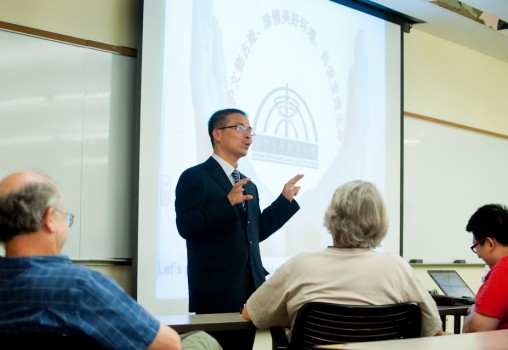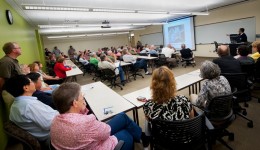
Terracotta warriors museum Chief Chemist Rong Bo talked about the preservation techniques they use on recovered artifacts.
A Wright State University audience got a lesson in preservation techniques from the chief chemist of a world-class museum at a spectacular archaeological reserve and mausoleum of China’s first emperor.
About 80 Wright State students, teachers, administrators and others crowded into a campus classroom Aug. 13 to hear the public presentation by Rong Bo, chief chemist of the Museum of Terracotta Soldiers and Horses of Shi-Huang-Di.
The presentation was part of a visit and new partnership initiative between the museum and Wright State.
The museum is part of an archaeological site and mausoleum in which thousands of terracotta soldiers and other figures depicting the armies of China’s first emperor, Qin Shi Huang, were unearthed. It is believed to be one of the most important findings of the 20th century.
The funerary art was buried with the emperor in 210 to 209 B.C. to protect him in the afterlife and was discovered by some farmers in 1974. The mausoleum is a World Heritage Site, listed by the United Nations, Educational, Scientific and Cultural Organization as of special cultural and/or physical significance. Last year it attracted 5 million visitors.
The museum’s labs are working to restore and preserve the terracotta figures, which are made of a clay-based ceramic. Most of the soldiers that were excavated had colors, but the colors can fade quickly when exposed to the air.
In his presentation at Wright State, Bo discussed and showed photos of research and conservation efforts at the museum, noting that only three of the excavation pits of more than 600 have been opened to the public so far.
Bo said the terracotta warriors were larger than life-sized. The torsos, hands and feet were produced separately and then joined together. The sculptures were fired at temperatures of more than 1,800 degrees Fahrenheit and then painted.
The figures were multicolored, displaying a rainbow of colors. Bo detailed the chemistry of the pigments, some of which contained animal blood. Slides of microscopic cross-sections of the pigments revealed different techniques. Often, several layers of pigments were used on the faces and hands.
Bo was peppered with questions: How long did it take to produce the figures? Did preservation require controlled humidity? What were the benefits of using animal blood in the pigments?
Several Wright State public history graduate students attended the presentation.
Kaitlyn Goss, of Clayton, was impressed with how fast the pigments could deteriorate after the sculptures are excavated.
“I was just blown away at how quickly the paint would peel off. That was a shock to me,” she said “How do you even begin to save that?’”
Marcus Manchester, of Dayton, was also interested in the preservation techniques.
“What I’ve been doing lately is conservation and curatorial work at the Clark County Historical Society, so hearing that is very interesting,” he said. “It would be interesting to understand a little more of the technical aspects of it, but that would take years of learning.”
Sarah Aisenbrey, of Dayton, said many of her classes in museum studies deal with preserving objects.
“It’s interesting to see someone from another country doing the same things we’ve learned about using terms that we understand,” she said.
Stephen Foster, Wright State’s associate vice president for international affairs, said the public presentation was part of an effort to bring in as many Wright State and community people as possible.
“We’re hoping for whatever interest there might be in some exchanges, visits and so on,” Foster said.
Hunt Brown, director of sustainability at Wright State, was drawn to the presentation by his longstanding interest in anthropology.
“They seem to be making a great deal of effort to ensure conservation of the cultural artifacts,” Brown said. “It’s obviously important to make all efforts to conserve something that’s unique in the world.”
Prior to the presentation, Bo and Vice Curator Wang Mingsheng met with officials and students in Wright State’s public history program and took part in a roundtable discussion with officials from the National Museum of the United States Air Force. Later, Bo was scheduled to meet with Wright State experts in chemistry, physics and sensors in hopes of some technical interchange.
Wright State is the only U.S. university to have such a partnership with the museum, which has similar agreements with the Ludwig-Maximilian University of Munich, Germany; Oxford University and University of London, England; and the University of British Columbia, Canada.


 Wright State University Foundation awards Students First Fund grants
Wright State University Foundation awards Students First Fund grants  Cosmic collection
Cosmic collection  Wright State revives student-faculty collaborative writing journal
Wright State revives student-faculty collaborative writing journal  Fulfilling dreams
Fulfilling dreams  Wright State alumna Nicole Scherzinger wins top British theatre award as star of ‘Sunset Boulevard’
Wright State alumna Nicole Scherzinger wins top British theatre award as star of ‘Sunset Boulevard’ 